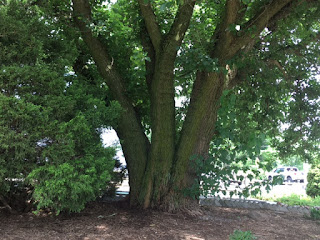CONCUSSION!
My mind, like that of too many NFL players, seems to be in a muddle. I have always enjoyed watching football. From high school days, our team was state ranked with a number of winning seasons. From 1961 to 1965, the Clarke Co. High School Eagles team had a record of 47-1-1 including four undefeated seasons. I grew up with “Friday night lights.”
When I was at William & Mary, the coach was none other than Marv Levy who ended up as the head coach of the Buffalo Bills from the late 1980s through the 1990s. I saw winning football.
Why is it that a sport that encourages fraternity and loyalty (do you know any Hokie fans?), has plenty of dramatic, emotional action, shows the physics and poetry of the human body in the confines of geometric space (i.e. the field), and encapsulates the unpredictability and electricity of life has become so rife with a problem that must be addressed?
This photo from the recent Sunday NY--Denver game shows both the beauty and the potential harm. Note the head positions as well as the balletic leg.
This chart shows the problems. What can be done? What is being done? Football causes brain damage. What a simple sentence!
What a tragedy and what a travesty! Here are some scary facts from a variety of magazine articles and internet sites:
· Most concussions occur without losing consciousness
· Common symptoms which may or may not show up include imbalance, headaches, confusion, vision and hearing changes, and mood swings
· Statistics on diagnosed concussions from the NFL:
2012 – 261
2013 – 229
2014 – 206
2015 – 275
2017 -214
Way back in 1994, NFL Commissioner Paul Tagliabue created the Mild Traumatic Brain Injury Committee. The doctor who was chairman had no prior experience in diagnosing brain injuries. Not much happened except acknowledgment by the “men upstairs” that brain injuries were an issue.

Then Dr. Bennet Omalu, a forensic pathologist, along with others founded the Brain Injury Research Institute and Chronic Traumatic Encephalopathy (CTE) publicized a report on the examination of the brain of Steeler Mike Webster, aged 50, who committed suicide. This was in 2002. Three years later, Dr. Omalu identified CTE in both pro players Terry Long and Andre Waters in autopsies after suicides.
In the fall of 2007, the NFL held a medical conference on concussions and issued guidelines. Particularly noted was an established hotline for players to report if they were forced to play against medical advice.
Moving along, Congress, in its infinite wisdom, held a House Judiciary Committee hearing on legal issues relating to football injuries. The NFL Commissioner defended the League. In 2010, Dr. Ira Casson, a member of that 1994 committee of Mild Traumatic Brain Injust denied the link between repeated head impacts and long-term brain damage. (HUH?! Still in denial?)

In 2010, 2011, and 2012 saw more suicides and collateral brain injuries. The issue becomes more public and controversial – 80 plus concussion-related lawsuits were filed on behalf of 2000 NFL players in federal court in Philadelphia. (Multi-District Litigation Case No. 2323)
The NFL filed a motion to dismiss and donated $30 million to NIH for research on “medical conditions” of athletes. In the class action lawsuit of 2013, the NFL agreed to pay $765 million to fund medical exams, concussion-related compensation, as well as litigation expenses. The lawyers continued their days in court with Dan Marino and 14 other NFL players suing the NFL over concussions - claiming the NFL knew for years of the link between concussions and long-term health problems. In 2014 a doctor released his report that NFL linebacker Jovan Belcher had CTE when he killed his girlfriend and himself. This was followed by Frank Gifford’s family saying that he suffered from CTE.
Last year - 2016 – they’ve been passing this issue around since 1994 – a policy was implemented to enforce concussion protocol. This past July a study in the medical journal (JAMA) identified CTE in 99% of the deceased NFL players whose brains were examined. That was 110 out of 111 brains.
New helmets are being designed as you read this. Some of the best identified are:

Before I close, let’s go back to Dr. Bennet Omalu. “Every child who plays football has a 100 percent risk of exposure to brain damage. It doesn’t mean all will get CTE, but some damage.”
Ridley Scott, noted film producer, was so taken with Omalu he produced movie “Concussion” starring Will Smith. I recommend this movie to learn about Dr. Omalu and his findings.
So, my fellow sports fans and savvy readers--does football stay the popular sport it is?
Do you want your child to play football? Will new helmets help?
Because I love cartoons, I ask: is this what is coming?
Glenne






































